Last Updated on December 3, 2024 by Kittredge Cherry
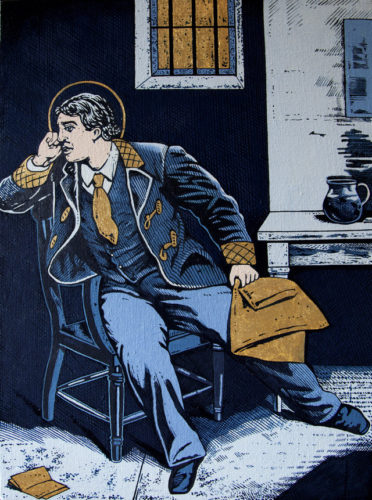
Oscar Wilde is a 19th-century Anglo-Irish writer whose reputation as a gay literary martyr and LGBTQ role model often overshadows his spiritual journey as a follower of Christ and Anglican convert to Catholicism. He died on Nov. 30, 1900, after a deathbed conversion.
Both his sexuality and his spirituality are evoked by the art installation: the Oscar Wilde Temple, which was exhibited at Studio Voltaire in London in 2018-19 after completing an exhibition in New York City.
A temple devoted to Oscar Wilde is not as odd as it may sound. Although he is better known as a forerunner of modern LGBTQ activism, the flamboyant and witty Wilde was also a spiritual seeker. He loved church rituals and took Christ seriously, especially during and after prison. He identified with Jesus as a persecuted rebel artist with an individual vision, writing, “Christ’s place indeed is with the poets.”
Oscar Wilde (Oct. 16, 1854 – Nov. 30, 1900) is best known for his ever-popular works “The Picture of Dorian Gray” and “The Importance of Being Earnest” — and his notorious imprisonment for homosexuality. Wilde’s lifelong flirtation with Catholicism ended with a flourish in a deathbed conversion.
Wilde’s imprisonment for “gross indecency” stemmed from his relationship with Lord Alfred “Bosie” Douglas, the poet who famously wrote about their same-sex desire as “the love that dare not speak its name.” But while in prison, Wilde wrote that Christ “took the entire world of the inarticulate, the voiceless world of pain, as his kingdom, and made of himself its external mouthpiece.”
During his prison stay, Wilde wrote a book-length letter to Douglas revealing an understanding of Christ that is as radical, unorthodox, creative and profound as the writings of today’s queer theologians.
 This letter, known as “De Profundis,” is included in “The Complete Works of Oscar Wilde” along with his many popular plays, poems, essays, novels and legendary one-liners.
This letter, known as “De Profundis,” is included in “The Complete Works of Oscar Wilde” along with his many popular plays, poems, essays, novels and legendary one-liners.
Oscar Wilde Temple echoes Catholic iconography
The Oscar Wilde Temple is conceived as “a welcoming secular space,” but it was located in the Church of the Village, a progressive United Methodist Church. A chapel there was transformed into a Victorian-era environment with devotional-style images of Wilde and contemporary martyrs of homophobia. It was created by the artists David McDermott and Peter McGough. The temple was open there before traveling to Studio Voltaire in London in fall 2018.
The centerpiece of the shrine is an altar built with a four-foot-tall wooden sculpture of Wilde. Around the statue are eight scenes from Wilde’s life presented as “stations” inspired by the Stations of the Cross.
“For more than 20 years, we have wanted to create ‘The Stations of Oscar Wilde to Reading Gaol,’ echoing the Catholic Church’s iconography and the ritual purpose of the Stations of the Cross,” McGough explains at oscarwildetemple.org.
The paintings show Wilde with a gilded halo, tracing his journey from arrest through imprisonment at Reading Gaol. They are based on engravings from English newspapers that covered Wilde’s trial and public humiliation.
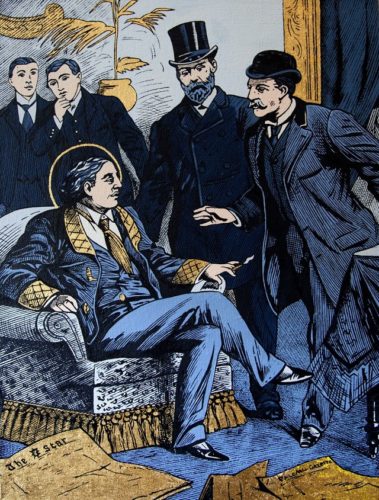
“Arrest of Oscar Wilde at the Cadogan Hotel” by McDermott & McGough (from “The Stations of Oscar Wilde to Reading Gaol”)
The artistic duo called “McDermott & McGough” conceived the Oscar Wilde Temple to transport visitors back to 1882-83, when Wilde made a hugely successful lecture tour of America. The Aesthetic Movement interior uses specially made fabric wall coverings, architectural and decorative details, furnishings and lighting to evoke Wilde’s era.
The temple also features a secondary altar honoring people with AIDS and McDermott & McGough’s portraits of key contemporary “martyrs” of homophobia and the AIDS epidemic. The Temple website states:
Among these are Alan Turing (1912-1954), considered the father of theoretical computer science and artificial intelligence; Harvey Milk (1930-1978), the first openly gay person to be elected to public office in California; Marsha P. Johnson (1945-1992), an African-American transwoman, sex worker, and gay liberation activist who played a central role in the Stonewall uprising; Brandon Teena (1972-1993), a transgendered boy from Lincoln, Nebraska, whose brutal rape and murder became a powerful symbol of transphobia in America; Xulhaz Mannan (1976-2016), murdered employee of the U.S. Embassy in Dkaka and founder of Roopbaan, Bangladesh’s first and only LGBT Magazine; and Sakia Gunn (1987-2003), a 15- year-old African-American lesbian who was stabbed in the chest while defending her sexuality in Newark, New Jersey. Additionally, the Temple will include plaques that commemorate two ministers from The Church of the Village’s own history – Rev. Paul M. Abels and Rev. C. Edward Egan – who were forced out of pastoral ministry in 1977 and 1984 for being gay.
Known simply by their linked surnames, McDermott & McGough gained notoriety in the bohemian downtown quarters of New York in the 1980s with their self-imposed immersion in the Victorian era. They lived as top-hat-wearing Victorian gentlemen for years, turning their lives into a performance-art “time experiment” to explore gay identity, societal repression, art history, and spiritual byways.
“The Temple is to be a place free of religious doctrine, honoring a watershed historical figure who pioneered the long struggle for equal rights for gays, lesbians, bisexual and transgender peoples – a struggle that has intersected with our nation’s larger effort to acknowledge, accept, embrace, and draw strength from the profound diversity that makes society stronger and enriches the lives of all people,” McDermott says on the temple’s website.
A video shows the press breakfast for the opening of the Oscar Wilde Temple at The Church of the Village. It includes remarks by pastor Jeff Wells, curator Alison Gingeras, artist Peter McGough, and Glennda Testone, executive director of the LGBT Community Center.
Oscar Wilde’s life began with spiritual conflicts
Oscar Fingal O’Flahertie Wills Wilde was born in Dublin, Ireland on Oct. 16, 1854. He was baptized as an infant into the Anglican church. When he was four or five years old, his mother arranged for a secret second baptism into the Catholic church, helping establish a lifelong conflict between the two faith traditions. His whole life can be seen as “a long and difficult conversion to the Roman Catholic Church,” according to an article by Catholic scholar Andrew McCracken.
Wilde attended Catholic mass, benedictions and papal audiences off and on throughout his lifetime. He was drawn to the ritual, passion, pageantry and sensuality of Catholicism. Many other 19th- and early 20th-century British LGBTQ literary and intellectual figures were converts to Catholicism, including Radclyffe Hall, John Henry Newman and Gerard Manley Hopkins. Lord Alfred Douglas, Marc-André Raffalovich, John Gray and Siegfried Sassoon. Christina Rossetti was deeply involved in the Anglo-Catholic movement without actually converting. As Wilde quipped, “The Roman Catholic Church is for saints and sinners alone – for respectable people, the Anglican Church will do.”
His father was an agnostic who discouraged his son’s interest in Catholicism. He feared that it might prevent his admission to the predominantly Anglican Oxford University. Indeed he did study at Oxford, where he reportedly filled his dorm room with photos of Cardinal Manning and Pope Pius IX. In 1877 he made his first trip to Rome. A friend even managed to arrange for him to have an audience with Pope Pius IX, a meeting that left Wilde “speechless.” After graduation in 1878, he went on to success as a writer and a variety of love relationships with both men and women. This included heterosexual marriage to Constance Lloyd Wilde, with whom he had two children.
His plays illuminated the complex interconnection between sin, deception and redemption, and included clever spiritual insights such as:
“The only difference between the saint and the sinner is that every saint has a past and every sinner has a future.”
And
“When the gods wish to punish us, they answer our prayers.”
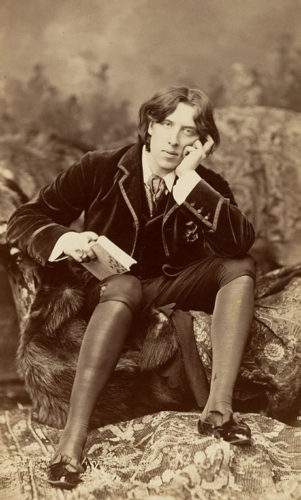
Oscar Wilde, 1882. Photo by Napoleon Sarony. (Wikipedia)
 Critics were scandalized by Wilde’s 1890 novel “The Picture of Dorian Gray.” They condemned it as immoral for its homosexual allusions and decadent theme of a beautiful young man who sells his soul for eternal youth. The clearest references to homosexuality were deleted from the standard versions of the novel, but an uncensored version is available now. The main character, Dorian Gray, keeps a hidden painting of himself that ages in his place.
Critics were scandalized by Wilde’s 1890 novel “The Picture of Dorian Gray.” They condemned it as immoral for its homosexual allusions and decadent theme of a beautiful young man who sells his soul for eternal youth. The clearest references to homosexuality were deleted from the standard versions of the novel, but an uncensored version is available now. The main character, Dorian Gray, keeps a hidden painting of himself that ages in his place.
Dorian Gray wanted to join the Catholic church, but instead gives in to vice and corruption. A vivid passage from the novel probably expresses some of Wilde’s own feelings disguised as Dorian’s attraction to the Catholic church:
It was rumoured of him once that he was about to join the Roman Catholic communion, and certainly the Roman ritual had always a great attraction for him. The daily sacrifice, more awful really than all the sacrifices of the antique world, stirred him as much by its superb rejection of the evidence of the senses as by the primitive simplicity of its elements and the eternal pathos of the human tragedy that it sought to symbolize. He loved to kneel down on the cold marble pavement and watch the priest, in his stiff flowered dalmatic, slowly and with white hands moving aside the veil of the tabernacle, or raising aloft the jewelled, lantern-shaped monstrance with that pallid wafer that at times, one would fain think, is indeed the “panis caelestis,” the bread of angels, or, robed in the garments of the Passion of Christ, breaking the Host into the chalice and smiting his breast for his sins. The fuming censers that the grave boys, in their lace and scarlet, tossed into the air like great gilt flowers had their subtle fascination for him. As he passed out, he used to look with wonder at the black confessionals and long to sit in the dim shadow of one of them and listen to men and women whispering through the worn grating the true story of their lives.
Scholars speculate that Dorian Gray was based on Wilde himself or on his friend John Gray, a homosexual poet who went on to become a Roman Catholic priest. His story is told in “The Man Who Was Dorian Gray” by Jerusha Hull McCormack.
Around the time of the novel’s publication, Wilde first met Douglas, the beautiful younger man who would lead to his downfall.
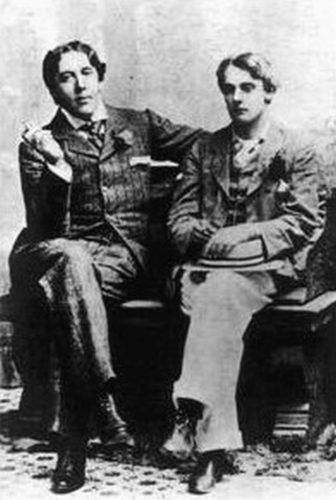
Oscar Wilde and Lord Alfred Douglas, 1893 (Wikipedia)
In his 1891 essay “The Soul of Man Under Socialism,” Wilde interpreted and celebrated Jesus: “He is a beggar who has a marvellous soul; he is a leper whose soul is divine; he needs neither property nor health; he is a God realising his perfection through pain.”
Wilde went on to expound eloquently on Christ as an individualist, including these lines:
“He who would lead a Christlike life is he who is perfectly and absolutely himself. He may be a great poet, or a great man of science; or a young student at a University, or one who watches sheep upon a moor; or a maker of dramas, like Shakespeare, or a thinker about God, like Spinoza; or a child who plays in a garden, or a fisherman who throws his net into the sea. It does not matter what he is, as long as he realises the perfection of the soul that is within him.”
Oscar Wilde’s prison writings about Christ
At the height of his popularity, when Wilde had two hit plays in London, he helped instigate his own downfall by ignoring advice and suing Douglas’ father for calling him a “sodomite.” After a series of sensational libel/sodomy trials, Wilde was convicted in 1895 of “gross indecency with other male persons” and sentenced to two years of hard labor at Reading Gaol.
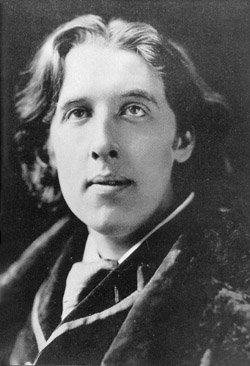
Oscar Wilde (Wikipedia)
The reading material that he requested in prison included the Bible, a life of Saint Francis of Assisi, and works by Saint Augustine and John Henry Newman, another British Catholic convert now considered a gay saint. Toward the end of his two-year imprisonment, Wilde was allowed to write — with one sheet of paper at a time. He used this opportunity to compose a long letter to Douglas with extensive reflections on Christ.
The epic letter is called “De Profundis,” a Latin phrase from the first line of Psalm 130, “Out of the depths I cry to you, O God.” In “De Profundis” he wrote of how the sufferings of prison can be transformed into “a spiritual experience” and “a spiritualising of the soul.” He also expressed a detachment from organized religion that is likely to resonate with many in today’s LGBTQ community:
“When I think of religion at all, I feel as if I would like to found an order for those who cannot believe: the Confraternity of the Faithless, one might call it, where on an altar, on which no taper burned, a priest, in whose heart peace had no dwelling, might celebrate with unblessed bread and a chalice empty of wine.”
Wilde built on his earlier writings about Christ as an artist, stating:
“I see a far more intimate and immediate connection between the true life of Christ and the true life of the artist.”
And
“Wherever there is a romantic movement in art there somehow, and under some form, is Christ, or the soul of Christ.”
Wilde’s Christ is no ordinary artist, but one whose creation is the whole world and whose love speaks for all outcasts. He wrote:
“To the artist, expression is the only mode under which he can conceive life at all. To him what is dumb is dead. But to Christ it was not so. With a width and wonder of imagination that fills one almost with awe, he took the entire world of the inarticulate, the voiceless world of pain, as his kingdom, and made of himself its external mouthpiece.”
With extraordinary grace Wilde described how sin can become a step toward holy transformation:
“The world had always loved the saint as being the nearest possible approach to the perfection of God. Christ, through some divine instinct in him, seems to have always loved the sinner as being the nearest possible approach to the perfection of man. His primary desire was not to reform people, any more than his primary desire was to a relieve suffering. To turn an interesting thief into a tedious honest man was not his aim. He would have thought little of the Prisoners’ Aid Society and other modern movements of the kind. The conversion of a publican into a Pharisee would not have seemed to him a great achievement. But in a manner not yet understood of the world he regarded sin and suffering as being in themselves beautiful holy things and modes of perfection.
It seems a very dangerous idea. It is—all great ideas are dangerous. That it was Christ’s creed admits of no doubt. That it is the true creed I don’t doubt myself.
Of course the sinner must repent. But why? Simply because otherwise he would be unable to realise what he had done. The moment of repentance is the moment of initiation. More than that: it is the means by which one alters one’s past. The Greeks thought that impossible. They often say in their Gnomic aphorisms, ‘Even the Gods cannot alter the past.’ Christ showed that the commonest sinner could do it, that it was the one thing he could do. Christ, had he been asked, would have said—I feel quite certain about it—that the moment the prodigal son fell on his knees and wept, he made his having wasted his substance with harlots, his swine-herding and hungering for the husks they ate, beautiful and holy moments in his life. It is difficult for most people to grasp the idea. I dare say one has to go to prison to understand it. If so, it may be worth while going to prison.”
“De Profundis” turned out to be Wilde’s final prose work before his death three years later.
Most of his friends withdrew their support while Wilde was in prison. Among the few that stuck with him are English artists Charles Ricketts and Charles Shannon, a gay couple who were depicted as medieval saints in a painting by Edmund Dulac.
While in jail, Wilde also witnessed the execution that he described after his release in his final poem, “The Ballad of Reading Gaol.” Christian themes are woven throughout the poem, expressing the depth of understanding that Wilde gained through his sufferings in prison in verse such as:
“How else but through a broken heart
May Lord Christ enter in?”
Oscar Wilde’s deathbed conversion
On the day he was released from jail, Wilde wrote to a Jesuit house in London requesting a six-month Catholic retreat. He wept bitterly when they refused, but later told a journalist, “I intend to be received into the Catholic Church before long.”
Bankrupt and estranged from his family, he soon moved to France and reunited temporarily with Douglas. Wilde lived under the pseudonym “Sebastian Melmoth,” based on Saint Sebastian, a patron saint of gay men. During three years of exile, Wilde mixed homosexual liaisons with piety, prayer and pilgrimages. He even traveled to the Vatican where he received multiple blessings from Pope Leo XIII.
With his health weakened by his prison stay, Wilde became dangerously ill with cerebral meningitis in 1900. His friend and sometimes lover Robert “Robbie” Ross had repeatedly promised to bring a Catholic priest to Wilde when he was dying, and so he did. Father Cuthbert Dunne, a Passionist priest from Dublin, recorded what happened when he arrived:
“Robert Ross knelt by the bedside, assisting me as best he could while I administered conditional baptism, and afterwards answering the responses while I gave Extreme Unction to the prostrate man and recited the prayers for the dying. As the man was in a semi-comatose condition, I did not venture to administer the Holy Viaticum; still I must add that he could be roused and was roused from this state in my presence. When roused, he gave signs of being inwardly conscious… Indeed I was fully satisfied that he understood me when told that I was about to receive him into the Catholic Church and gave him the Last Sacraments… And when I repeated close to his ear the Holy Names, the Acts of Contrition, Faith, Hope and Charity, with acts of humble resignation to the Will of God, he tried all through to say the words after me.”
Wilde died the next day on Nov. 30, 1900 at age 46 in Paris, France. His surviving family members include his lesbian niece Dorothy “Dolly” Wilde, whose longest relationship was with American writer and salon host Natalie Clifford Barney.
Some dismiss his deathbed conversion as an act of weakness by a sick and broken man, but his life and work affirm it as the culmination of an authentic spirituality journey. One friend described it as “a return to a first love.”
Oscar Wilde pardoned and honored
A small stained-glass memorial for Wilde was unveiled at Poets’ Corner in Westminster Abbey on Feb. 14, 1995. Sometimes admirers leave a tribute of green carnations, which became a queer symbol when he told his friends to wear them on their lapels for the 1892 opening of his comedy “Lady Windermere’s Fan.”

The Oscar Wilde stained-glass window at Westminster Abbey includes his name and the dates 1854 – 1900. (Detail from a photo at Wikipedia)
In 2017, Wilde received a posthumous pardon. He was one of an estimated 50,000 men pardoned in Britain for homosexual acts under the Alan Turing Law, named after the World War II codebreaker also convicted of “gross indecency.”
 Stephen Fry was nominated as best actor for a Golden Globe Award for playing the title role in the star-studded 1997 biographical film “Wilde.” In 2018 Wilde continued to be explored in a book analyzing his legacy “Making Oscar Wilde” by Michele Mendelssohn and the movie about the last three years of his life, “The Happy Prince,” starring Colin Firth.
Stephen Fry was nominated as best actor for a Golden Globe Award for playing the title role in the star-studded 1997 biographical film “Wilde.” In 2018 Wilde continued to be explored in a book analyzing his legacy “Making Oscar Wilde” by Michele Mendelssohn and the movie about the last three years of his life, “The Happy Prince,” starring Colin Firth.
Wilde is buried in Paris in a tomb with controversial sculptures blending homoerotic and Christian imagery and a special compartment for the ashes of Robert Ross. The epitaph on Wilde’s tomb is a verse from his poem “The Ballad of Reading Gaol”:
“And alien tears will fill for him
Pity’s long-broken urn,
For his mourners will be outcast men,
And outcasts always mourn.”
Queer British artist Tony O’Connell includes Wilde in his Litany of the Queer Saints as part of a performance-art film on Saint Sebastian. It includes this line: “Saint Oscar Wilde, our saint of humour, grace and elegance, whose gentle hands were put to hard labour, Pray for us.”
Books related to Oscar Wilde
“Making Oscar Wilde” by Michele Mendelssohn (Oxford University Press, 2018)
“Oscar Wilde” by Richard Ellmann (biography, winner of National Book Award and Pulitzer Prize)
“Catholic Figures, Queer Narratives,” edited by Lowell Gallagher, Frederick S. Roden and Patricia Juliana Smith
“The Faith of the Faithless: Experiments in Political Theology” by Simon Critchley
“The Complete Works of Oscar Wilde” (Collins Classics)
“Unruly Catholics from Dante to Madonna: Faith, Heresy, and Politics in Cultural Studies” edited by Marc DiPaolo. Includes a chapter “Wild(e) Religion: The Legacy of Oscar Wilde for Queer Theology” by Frederick Roden.
Links related to Oscar Wilde
De Profundis by Oscar Wilde, full text online
Soul of Man Under Socialism by Oscar Wilde, full text online
For This Artist Duo, a Third Act: A Shrine to Oscar Wilde (New York Times)
Oscar Wilde: A Church for Saints and Sinners (Queering the Church)
___
Top image credit:
“Oscar Wilde in Prison” by McDermott & McGough (from “The Stations of Oscar Wilde to Reading Gaol”)
___
This post is part of the LGBTQ Saints series by Kittredge Cherry. Traditional and alternative saints, people in the Bible, LGBTQ martyrs, authors, theologians, religious leaders, artists, deities and other figures of special interest to lesbian, gay, bisexual and transgender and queer (LGBTQ) people and our allies are covered.
This article was originally published on Q Spirit in 2017, was expanded with new material over time, and was most recently updated on Dec. 2, 2024.
Copyright © Kittredge Cherry. All rights reserved.
Qspirit.net presents the Jesus in Love Blog on LGBTQ spirituality.



















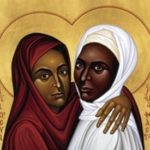
Another magnificent post. Thanks so much, Kittredge!